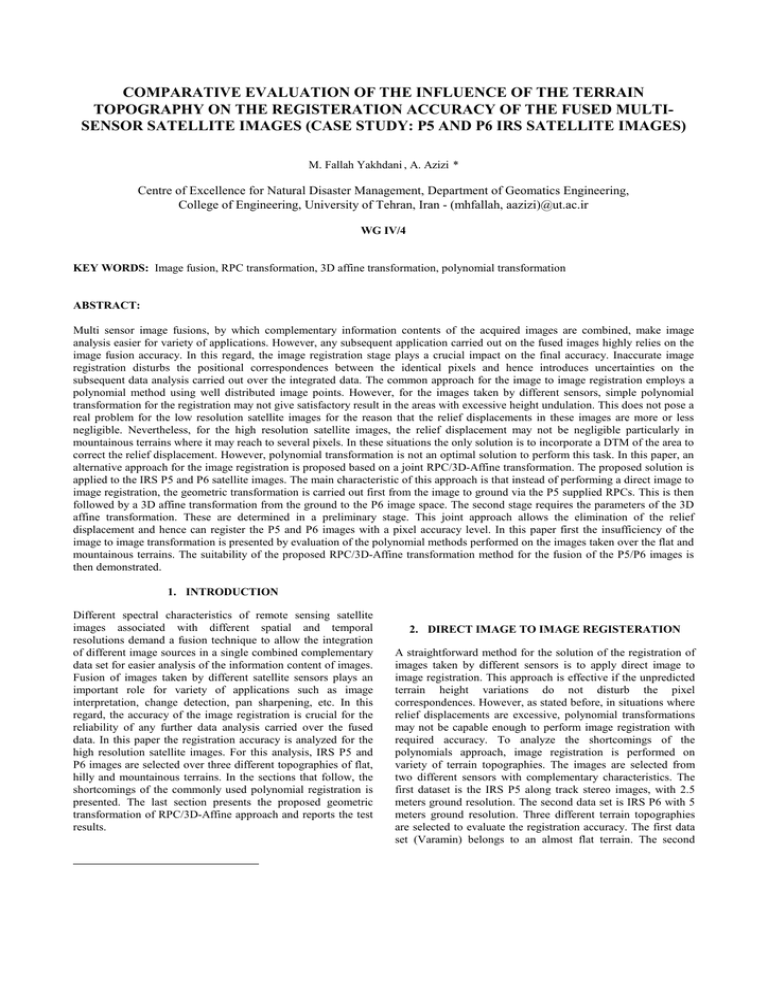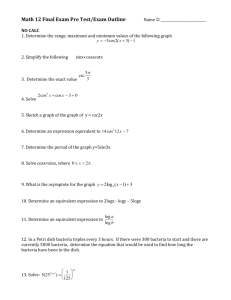COMPARATIVE EVALUATION OF THE INFLUENCE OF THE TERRAIN
advertisement

COMPARATIVE EVALUATION OF THE INFLUENCE OF THE TERRAIN TOPOGRAPHY ON THE REGISTERATION ACCURACY OF THE FUSED MULTISENSOR SATELLITE IMAGES (CASE STUDY: P5 AND P6 IRS SATELLITE IMAGES) M. Fallah Yakhdani , A. Azizi * Centre of Excellence for Natural Disaster Management, Department of Geomatics Engineering, College of Engineering, University of Tehran, Iran - (mhfallah, aazizi)@ut.ac.ir WG IV/4 KEY WORDS: Image fusion, RPC transformation, 3D affine transformation, polynomial transformation ABSTRACT: Multi sensor image fusions, by which complementary information contents of the acquired images are combined, make image analysis easier for variety of applications. However, any subsequent application carried out on the fused images highly relies on the image fusion accuracy. In this regard, the image registration stage plays a crucial impact on the final accuracy. Inaccurate image registration disturbs the positional correspondences between the identical pixels and hence introduces uncertainties on the subsequent data analysis carried out over the integrated data. The common approach for the image to image registration employs a polynomial method using well distributed image points. However, for the images taken by different sensors, simple polynomial transformation for the registration may not give satisfactory result in the areas with excessive height undulation. This does not pose a real problem for the low resolution satellite images for the reason that the relief displacements in these images are more or less negligible. Nevertheless, for the high resolution satellite images, the relief displacement may not be negligible particularly in mountainous terrains where it may reach to several pixels. In these situations the only solution is to incorporate a DTM of the area to correct the relief displacement. However, polynomial transformation is not an optimal solution to perform this task. In this paper, an alternative approach for the image registration is proposed based on a joint RPC/3D-Affine transformation. The proposed solution is applied to the IRS P5 and P6 satellite images. The main characteristic of this approach is that instead of performing a direct image to image registration, the geometric transformation is carried out first from the image to ground via the P5 supplied RPCs. This is then followed by a 3D affine transformation from the ground to the P6 image space. The second stage requires the parameters of the 3D affine transformation. These are determined in a preliminary stage. This joint approach allows the elimination of the relief displacement and hence can register the P5 and P6 images with a pixel accuracy level. In this paper first the insufficiency of the image to image transformation is presented by evaluation of the polynomial methods performed on the images taken over the flat and mountainous terrains. The suitability of the proposed RPC/3D-Affine transformation method for the fusion of the P5/P6 images is then demonstrated. 1. INTRODUCTION Different spectral characteristics of remote sensing satellite images associated with different spatial and temporal resolutions demand a fusion technique to allow the integration of different image sources in a single combined complementary data set for easier analysis of the information content of images. Fusion of images taken by different satellite sensors plays an important role for variety of applications such as image interpretation, change detection, pan sharpening, etc. In this regard, the accuracy of the image registration is crucial for the reliability of any further data analysis carried over the fused data. In this paper the registration accuracy is analyzed for the high resolution satellite images. For this analysis, IRS P5 and P6 images are selected over three different topographies of flat, hilly and mountainous terrains. In the sections that follow, the shortcomings of the commonly used polynomial registration is presented. The last section presents the proposed geometric transformation of RPC/3D-Affine approach and reports the test results. 2. DIRECT IMAGE TO IMAGE REGISTERATION A straightforward method for the solution of the registration of images taken by different sensors is to apply direct image to image registration. This approach is effective if the unpredicted terrain height variations do not disturb the pixel correspondences. However, as stated before, in situations where relief displacements are excessive, polynomial transformations may not be capable enough to perform image registration with required accuracy. To analyze the shortcomings of the polynomials approach, image registration is performed on variety of terrain topographies. The images are selected from two different sensors with complementary characteristics. The first dataset is the IRS P5 along track stereo images, with 2.5 meters ground resolution. The second data set is IRS P6 with 5 meters ground resolution. Three different terrain topographies are selected to evaluate the registration accuracy. The first data set (Varamin) belongs to an almost flat terrain. The second dataset (Arak) covers a hilly terrain while the third dataset (Roodehen) belongs to highly mountainous terrain topography. In the first data set 96 well defined image points are identified and measured in both P5 and P6 images. The same procedure is repeated for other datasets and 86 and 142 image points are respectively identified and measured. The distribution of the image points are given in Figure 1 for the three dataset. The failure of the polynomials to model the distortion patterns are due to the fact that the frequency of the height undulations is higher than the density and distribution of the image points. A possible approach to overcome this problem is to highly increase the number of the measured points and to densify their distribution over the image area. This may be impractical in some situations. An alternative solution is to incorporate the DEM of the area in an indirect solution to correct for the relief displacement. However, polynomial transformations are not optimal for this approach. 3. IDIRECT IMAGE REGISTERATION A simple solution to overcome the problem associated with the terrain topography is to perform an indirect registration scheme. That is, instead of a direct image to image registration, the registration is performed via an indirect transformation to the corresponding point on the ground for each individual pixel (Figure 2). This is quite practical bearing in mind that the generated RPCs are readily available for the high resolution satellite imageries. Direct image-to-image registration Indirect image registration Figure 2. Direct and indirect registration schemes. Figure 1. From top to bottom: measured image points distribution for datasets 1, 2 and 3 belonging to flat, hilly and mountanouse terrains respectively. For the solution of image to image registration different polynomial orders are utilized and the optimum terms are determined. The registration accuracy is then evaluated using rmse of the residuals in pixels for both of the check and control points. The control points are those image points that contribute to the solution of the polynomial coefficients. Table 1 indicates the overall rmse for the check points evaluated for all datasets. As can be seen from the Table, the greater the frequency of the terrain height undulation the larger the rmse values. In the case of the third dataset which belongs to a mountainous terrain the rmse for the check points approaches to 9 pixels. Terrain characteristics Dataset 1 (flat terrain) Dataset 2 (hilly terrain) Dataset 3 (mountainous terrain) rmse, (check points) pixel 2.0 3.4 9.4 Table 1. The overall rmse for the check points evaluated by optimum term polynomial transformations. The proposed scheme for the realization of the above strategy is a joint RPC/3D-Affine transformation which can be described as follows: Using the supplied RPCs the three dimensional coordinates are calculated for each pair of homologue points in the stereo along track P5 images using the following relations (see Grodecki et al., 2004): ∂K s = sO + s s ∂X ∂J l = lO + l s ∂X where ∂K ∂Y ∂J ∂Y 1 0 0 ϕs d ϕ ∂ K 1 0 d λ 0 ∂ Z λs dh 1 0 0 h s 1 0 0 ϕs d ϕ ∂ J 1 0 d λ 0 λs ∂ Z dh 1 0 0 h s (1) k and j denote the rational function equations respectively s, l = are the scan and line coordinates subscripts o and s indicate the shifts and scale factors respectively used for the normalization process the column vector comprises the unknown latitude, longitude and height differentials X,Y,Z are the normalized ground coordinates In the next stage, the correspondences are established between the object space points generated by the P5 RPCs and the related image points in the P6 image space. The well known 3D affine transformation given by the following relation is an appropriate solution in this regard (see Fraser, C.S. and Yamakawa, T., 2004): x' = A1 E + A2 N + A3h + A4 (2) y ' = A5 E + A6 N + A7 h + A8 where x’, y’ = pixel coordinates E, N, h = object coordinates Ai = the 3D affine transformation coefficients Using a minimum of 4 points for which both the image and object coordinates are known, the following resection equation gives the 8 3D affine coefficients: the registration stage. The DEM generation is performed using two approaches of the Global polynomial fit to the object space points and the delaunay triangulation followed by linear interpolation. The latter approach provided more accurate results. 5. CONCLUSION In this paper it is indicated that for the mountainous terrain used in this project, no combination of the term/order of the polynomials seems to satisfy the accuracy requirements for the image fusion. It is demonstrated that the indirect image registration is effective and practical. The proposed solution incorporates the supplied RPCs of the stereo images in a joint RPC/3D-Affine transformation scheme. The only requirement for the solution of this transformation is to have stereo images with the supplied RPCs. No ground control points are needed since the generated 3D object coordinates by the RPCs serve as the control points for the solution of the 3D affine coefficients. References x' − A4' A1' y ' − A' A' 8 = 5 x" − A" A" 4 1 y" − A"8 A" 5 ' A2 A6' A"2 A"6 A3 E A7' N A3" h A"7 ' (3) This scheme is carried out for all three datasets and the rmse results for the check and control points are presented in Table 2. Quite expectedly, the joint solution effectively has improved the registration accuracy for the third dataset which belongs to the images taken from a highly mountainous terrain. The rmse of 9 pixels with the polynomial solution is reduced to almost a pixel level with the indirect approach. Terrain characteristics Dataset 1 (flat terrain) Dataset 2 (hilly terrain) Dataset 3 (mountainous terrain) rmse,x,y (check points) Pixel 0.59, 0.58 0.9, 2.9 0.4, 0.6 Table 2. The overall rmse for the check points evaluated using the joint RPC/3D-affine transformation. 4. INDIRECT PIXEL BY PIXEL TRANSFORMATION After the computation of the indirect registration parameters of the P5-object-P6 transformation, in the next stage each individual pixel in the P5 space is transferred to the P6 space and a grey value is interpolated and based on an appropriate image fusion strategy, the final fusion is carried out. To transfer each individual pixel from the P5 to the ground, the following approach is adopted: For each pixel in the P5 space, three dimensional object space coordinates can be computed using two equations (equation 1) in three unknowns that can be solved by incorporating an approximate DEM generated by the computed object points in Fraser, C.S. and Yamakawa, T., 2004. Insights into the Affine Model for Satellite Sensor Orientation. ISPRS Journal of Photogrammetry and Remote Sensing, 58(5-6), pp. 275–288. Grodecki, J. and Dial, G. Lutes, J., 2004. Mathematical Model for 3D Feature Extraction from Multiple Satellite Images Described By RPCs. In: ASPRS Annual Conference Proceedings, Denver, Colorado.


